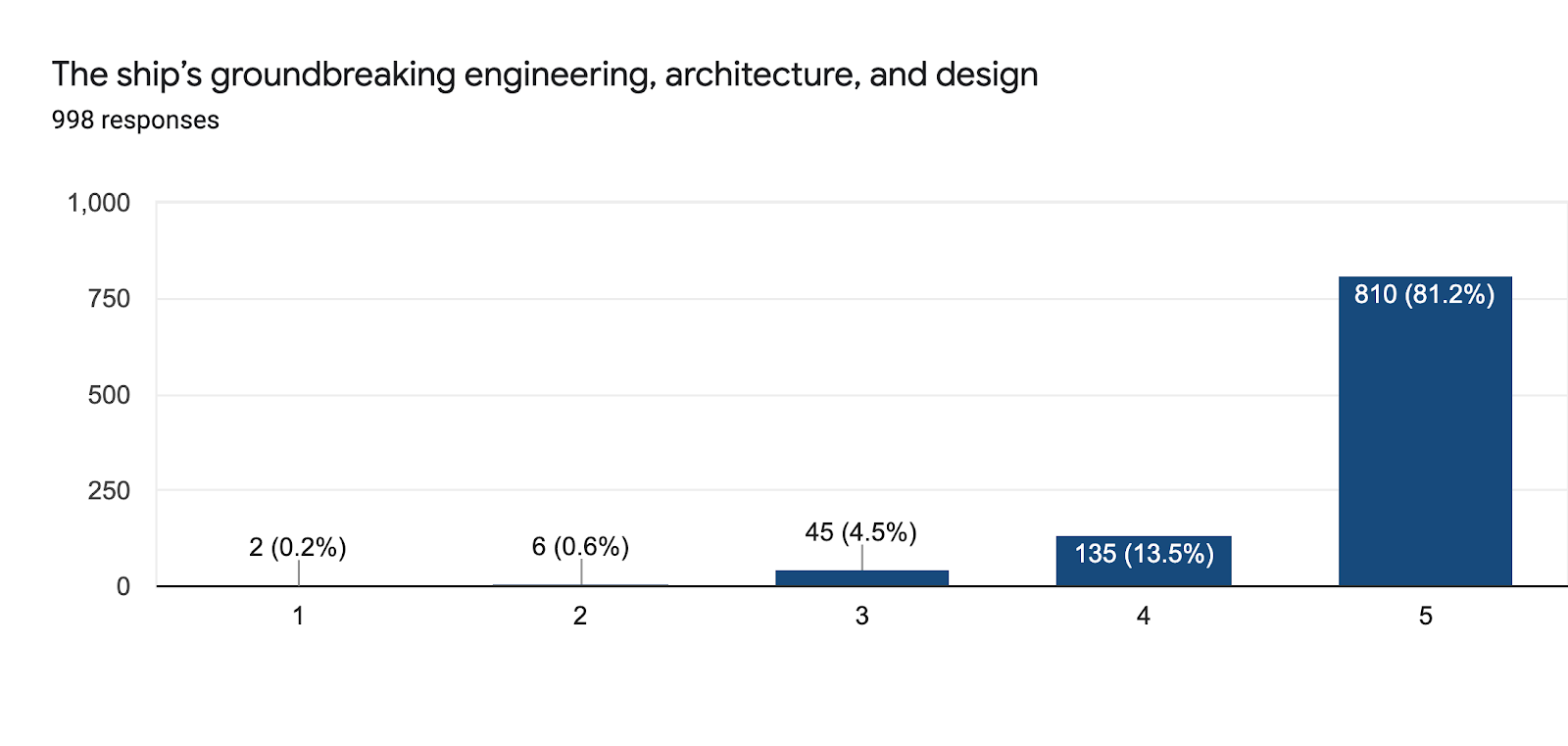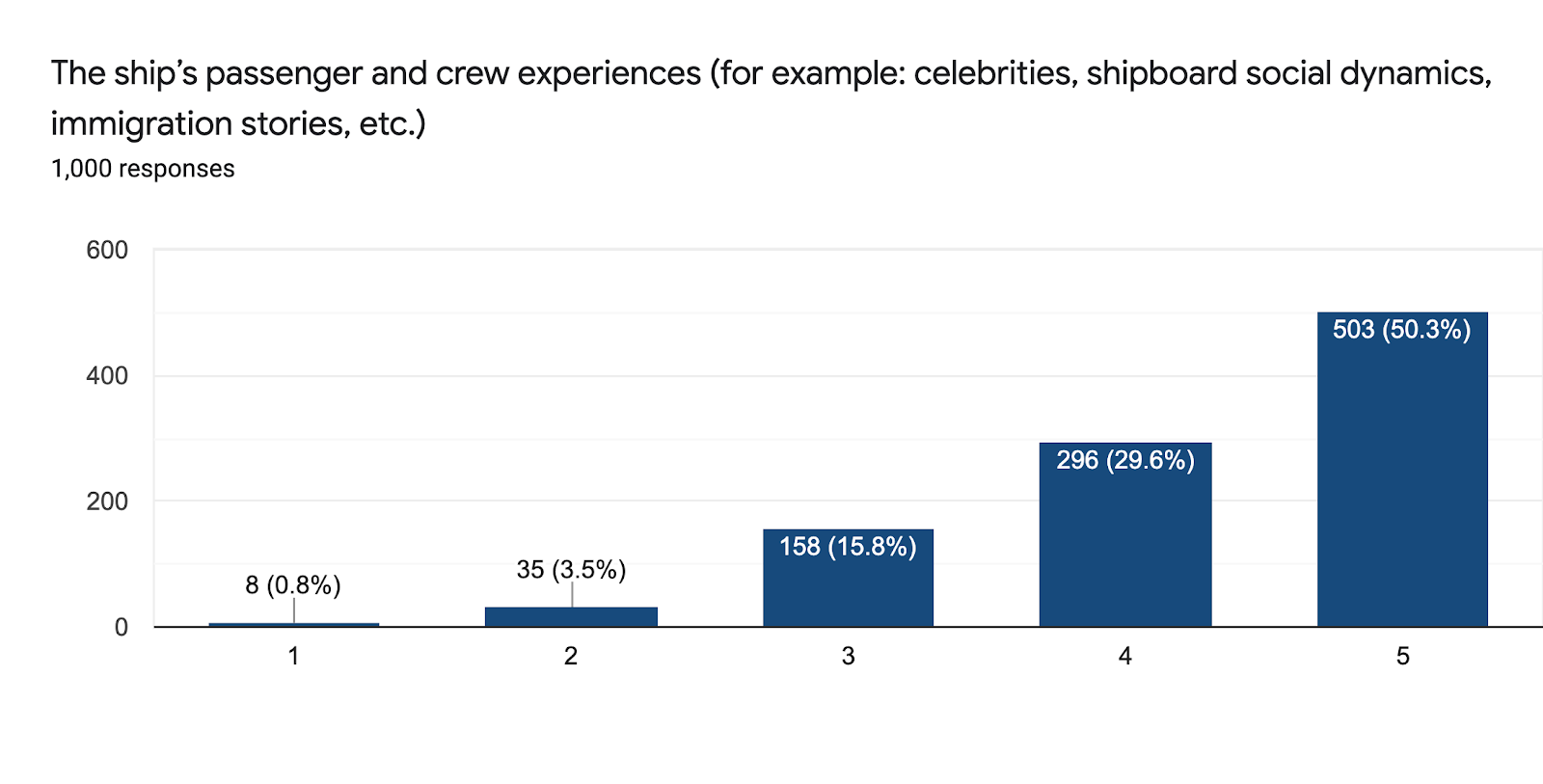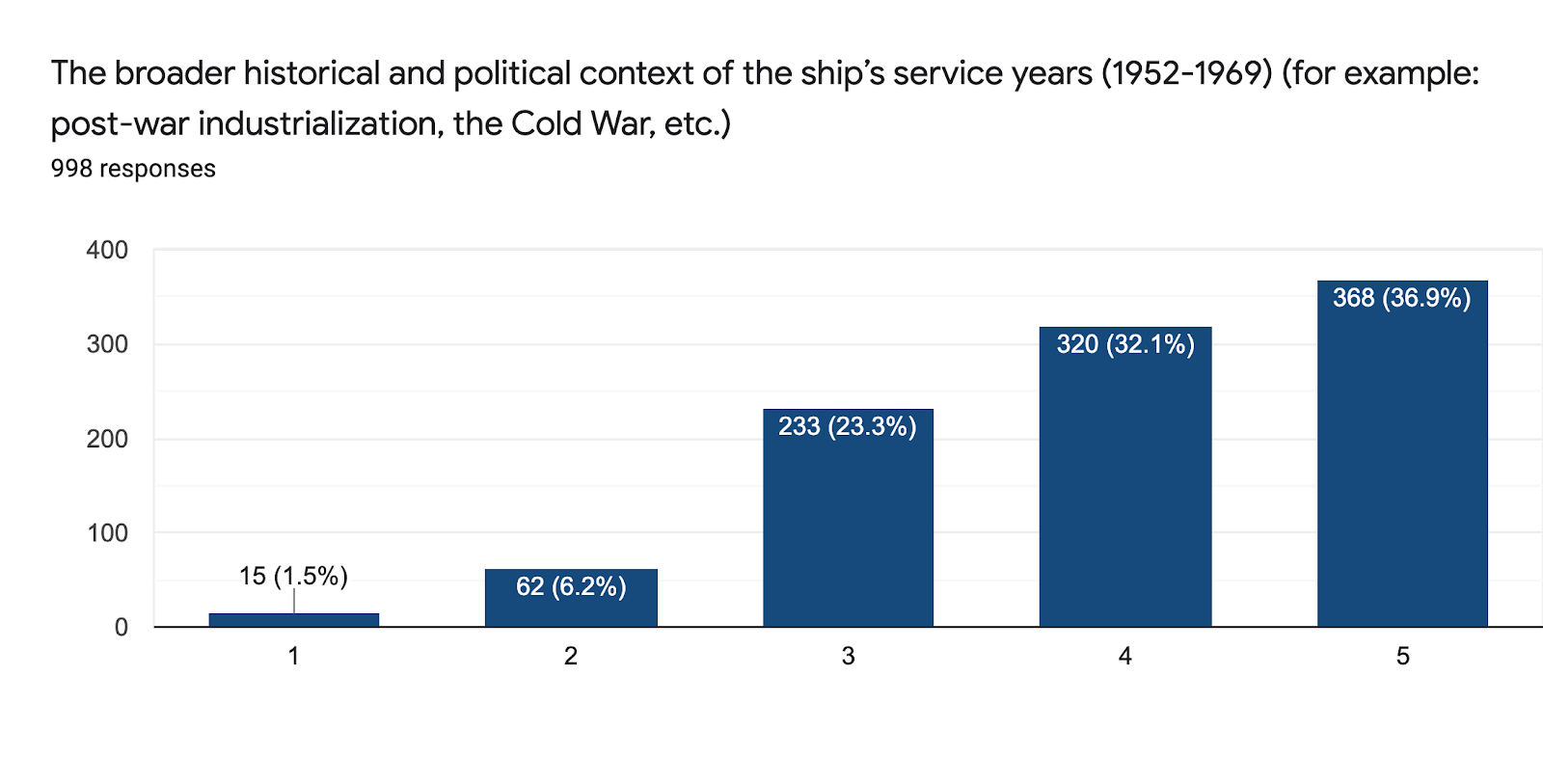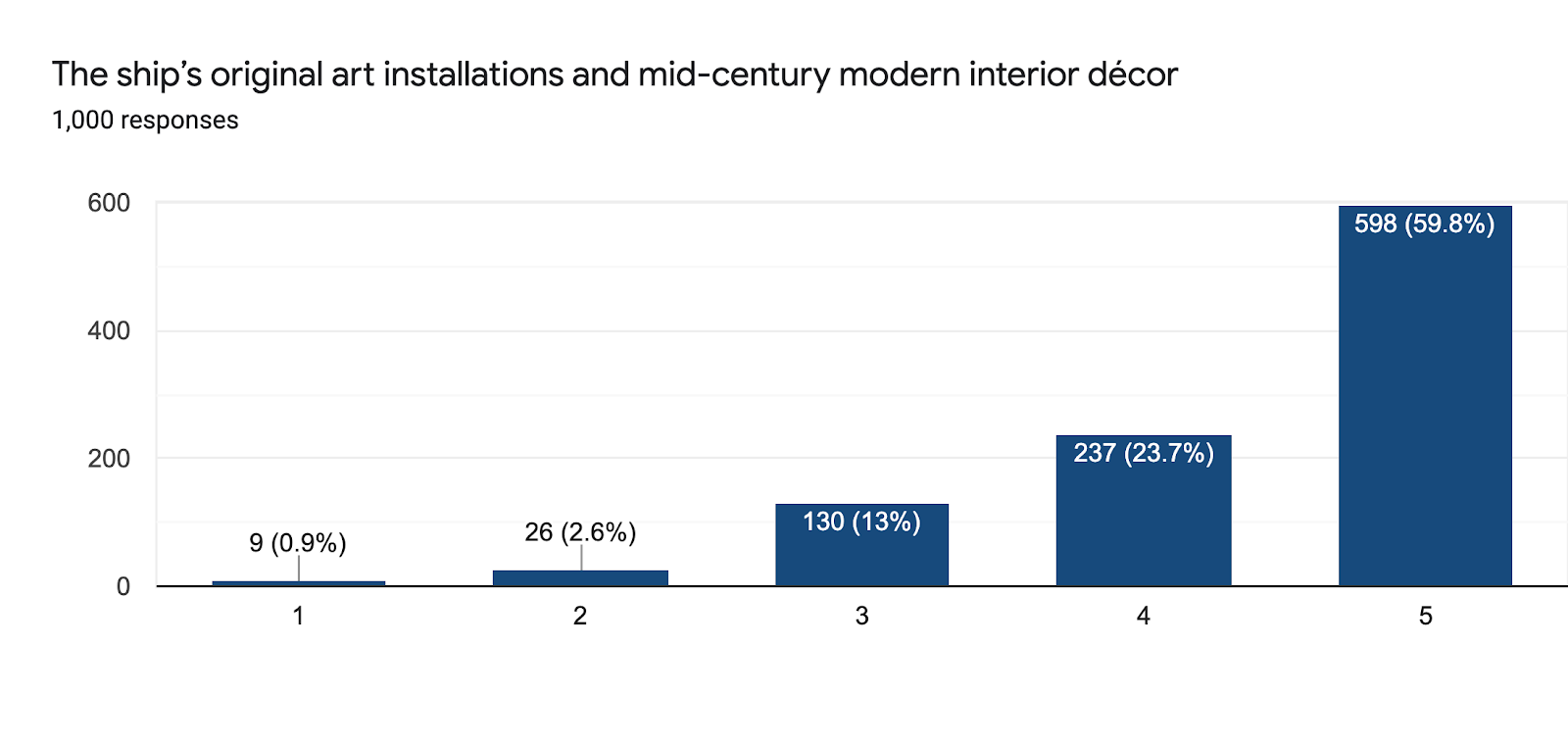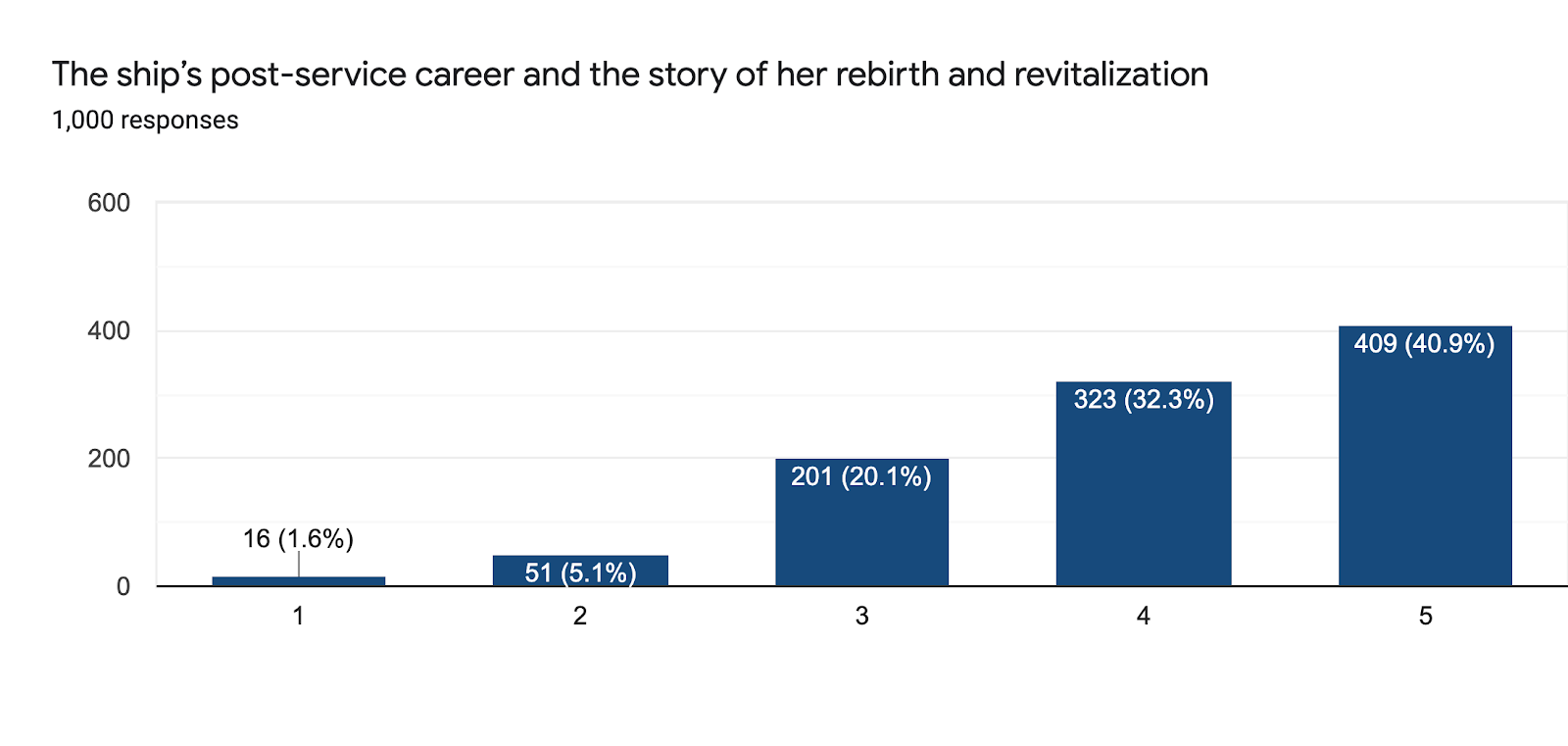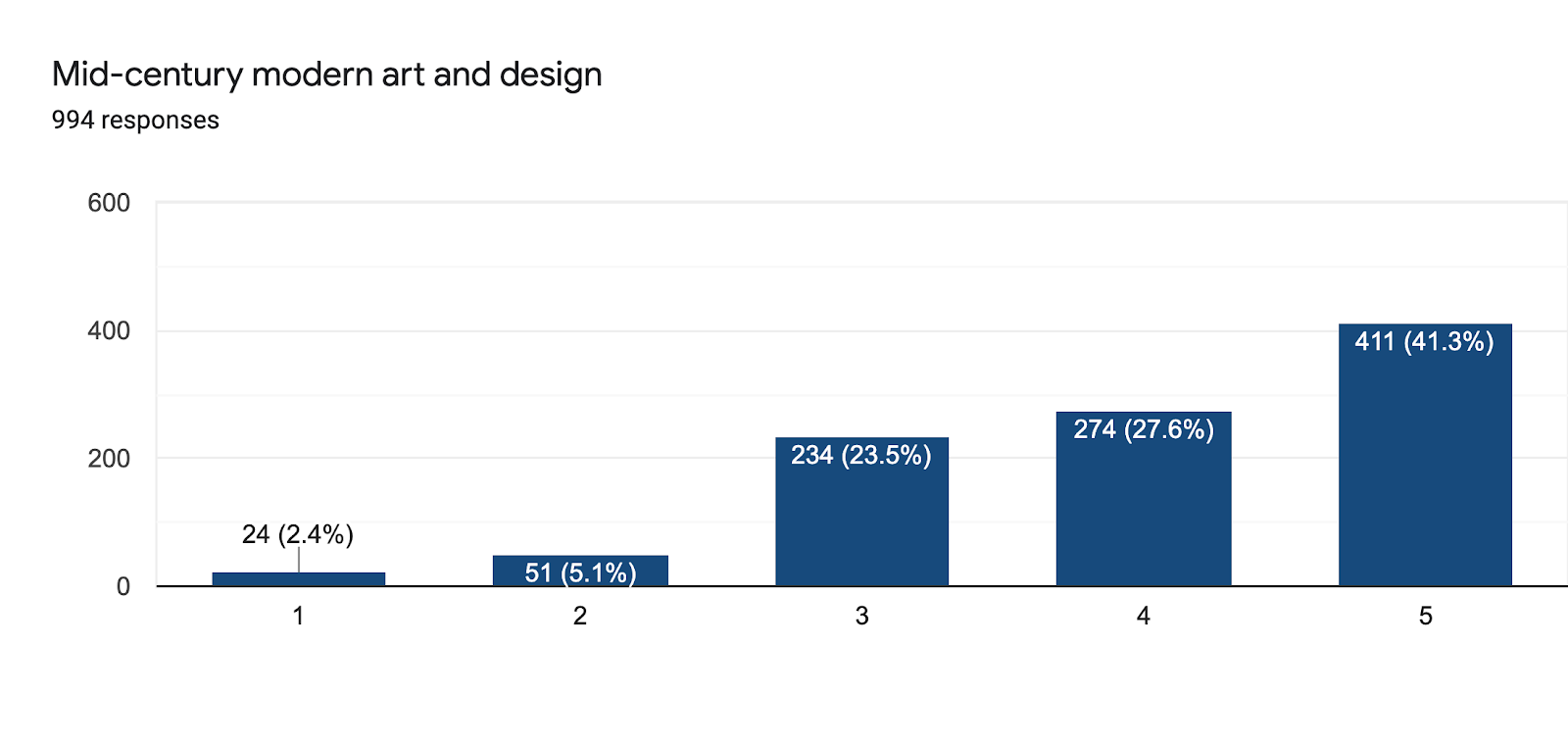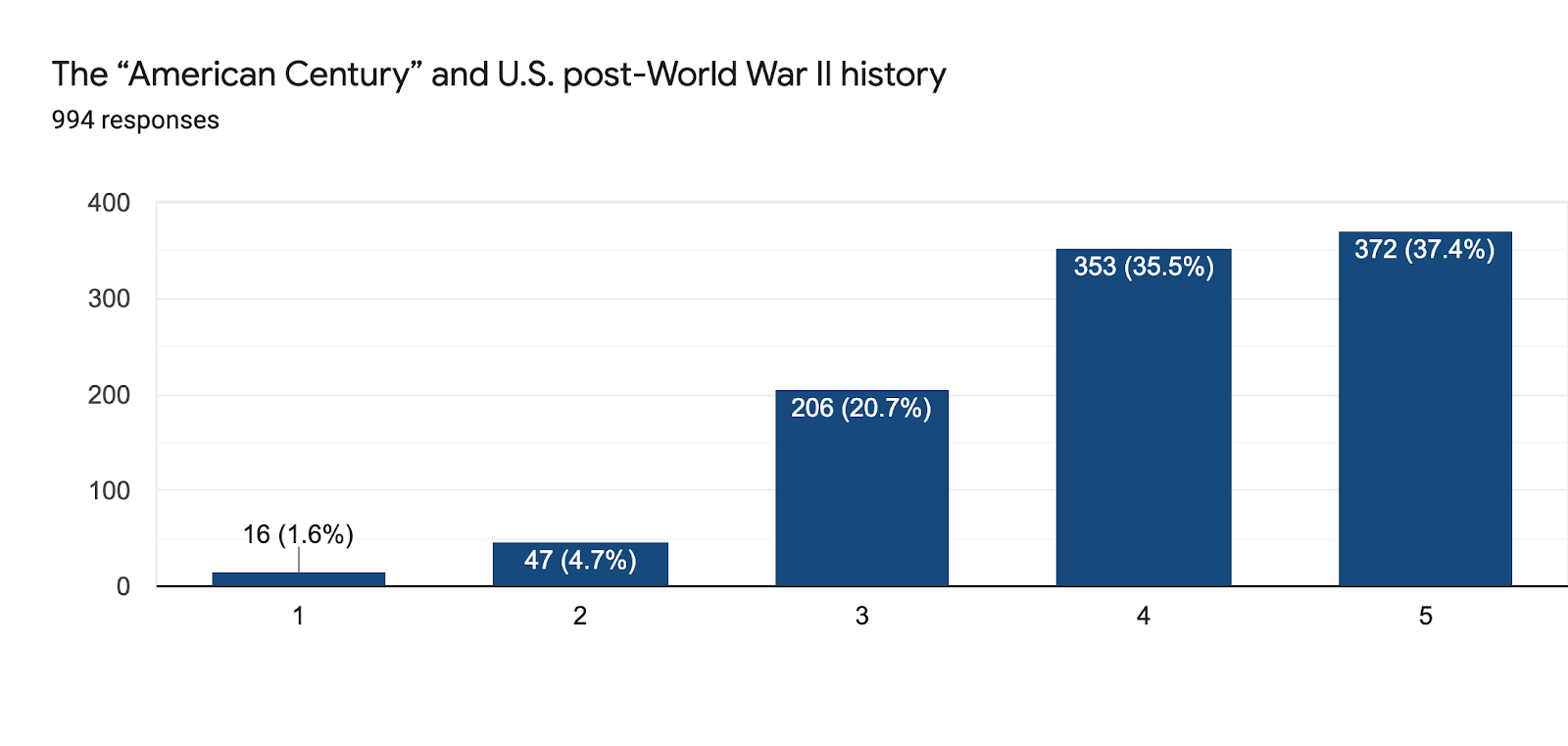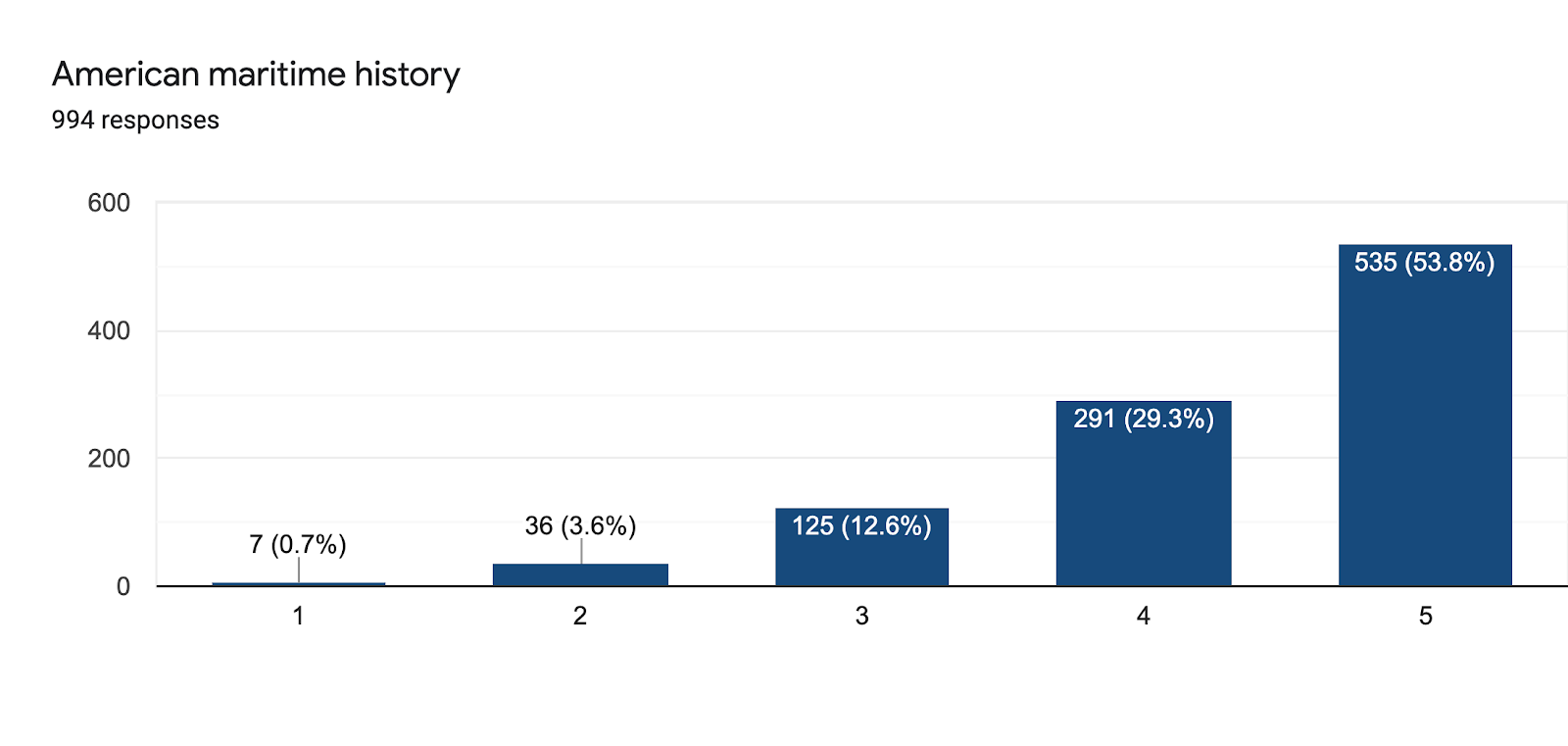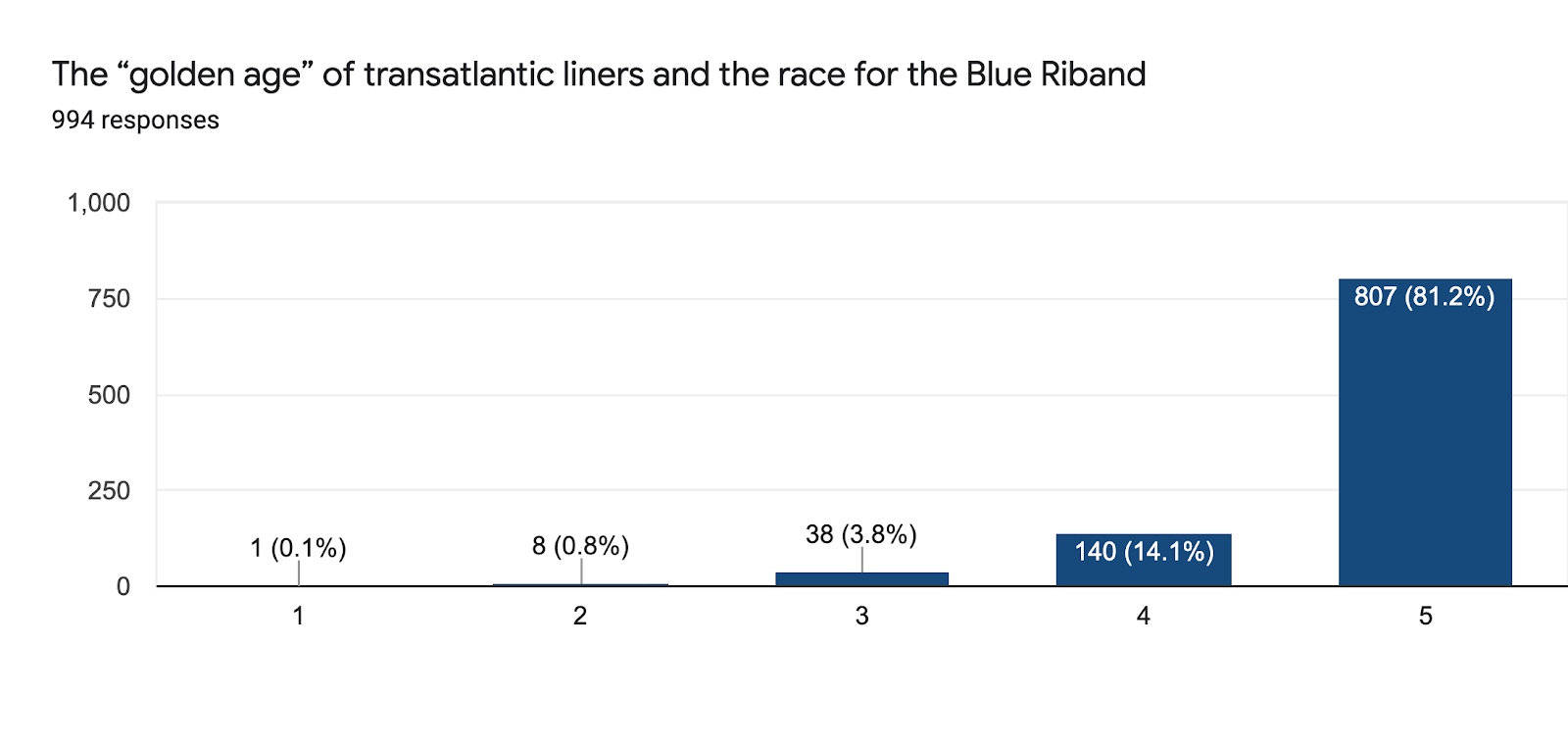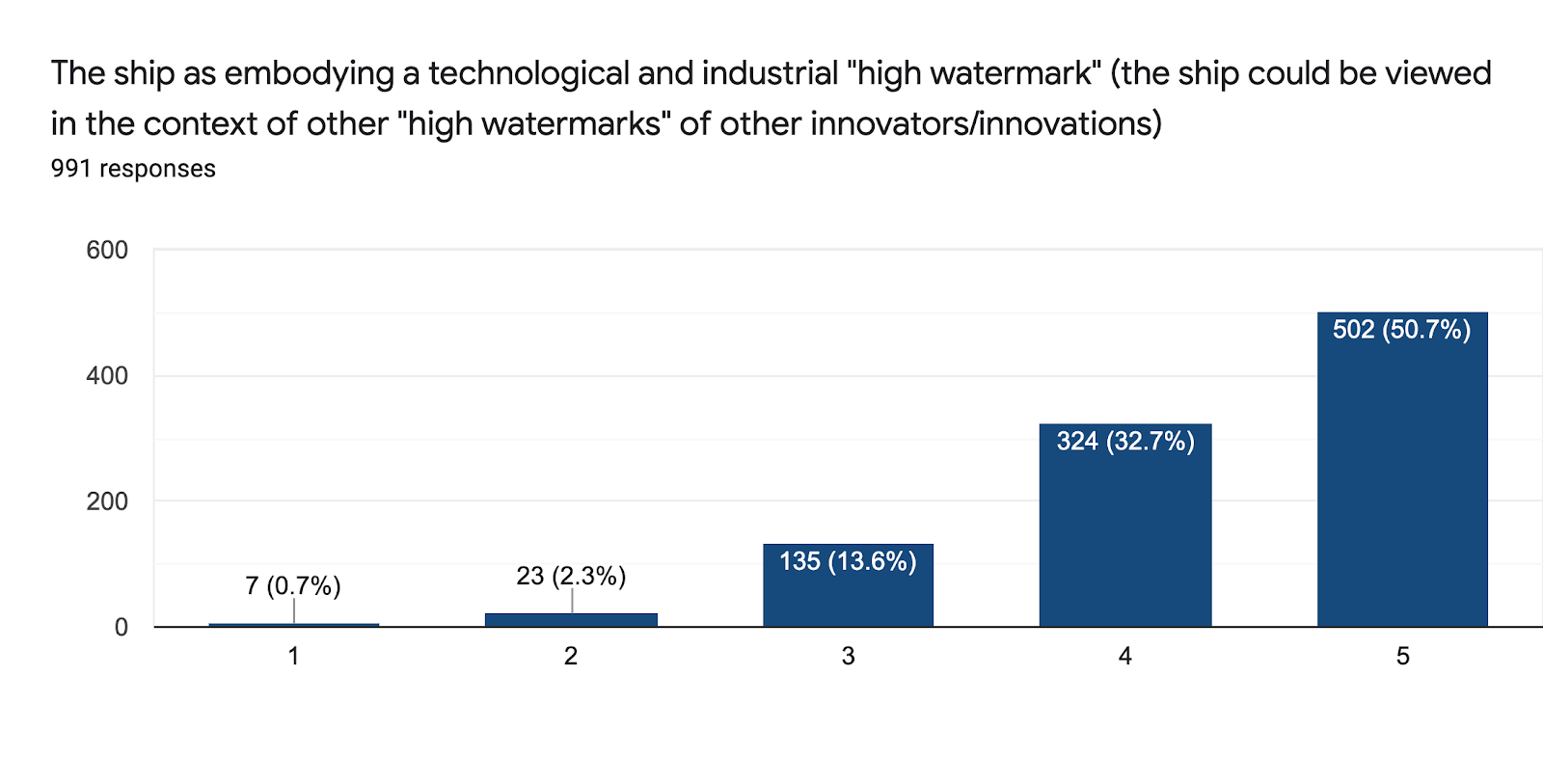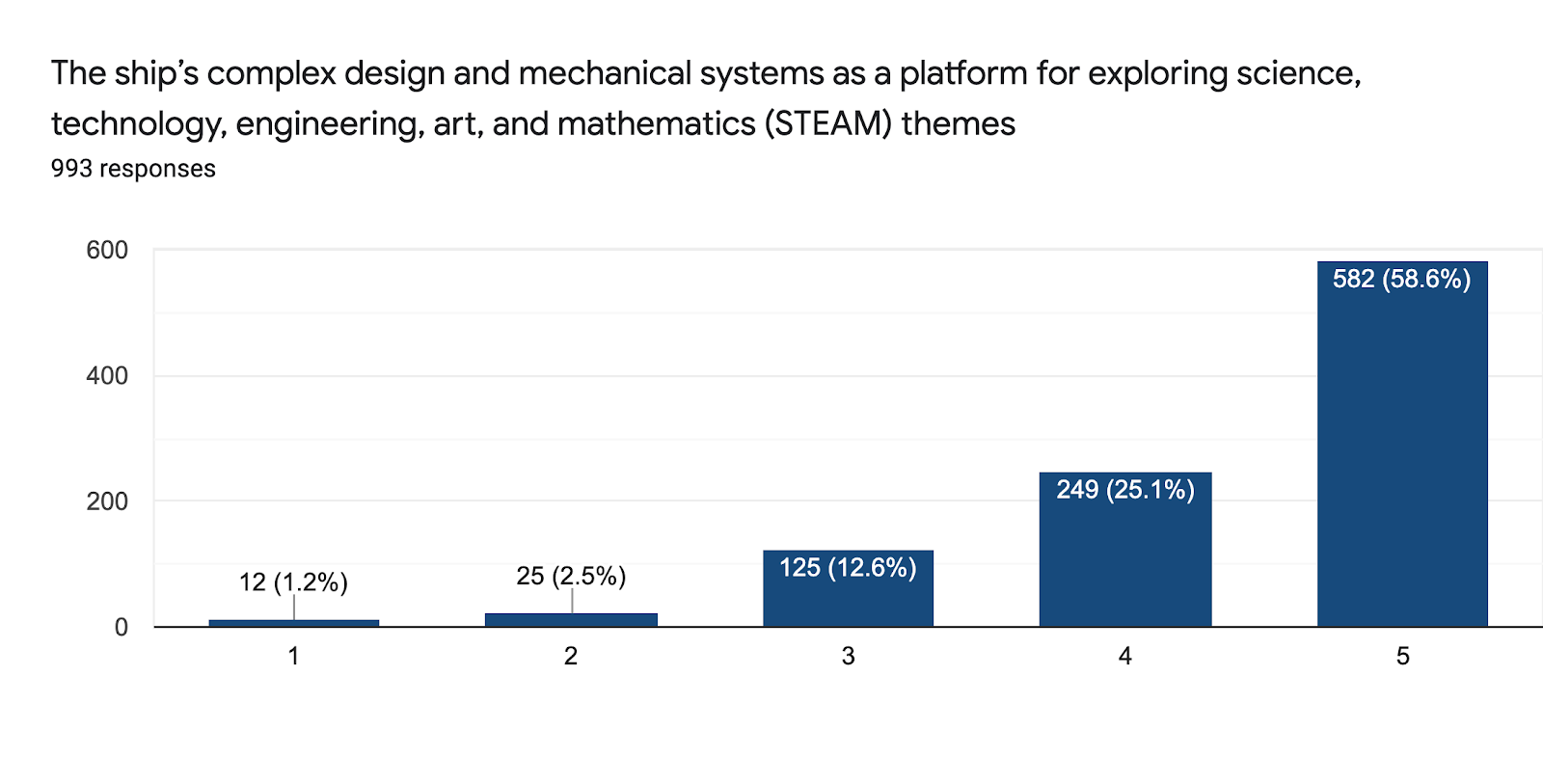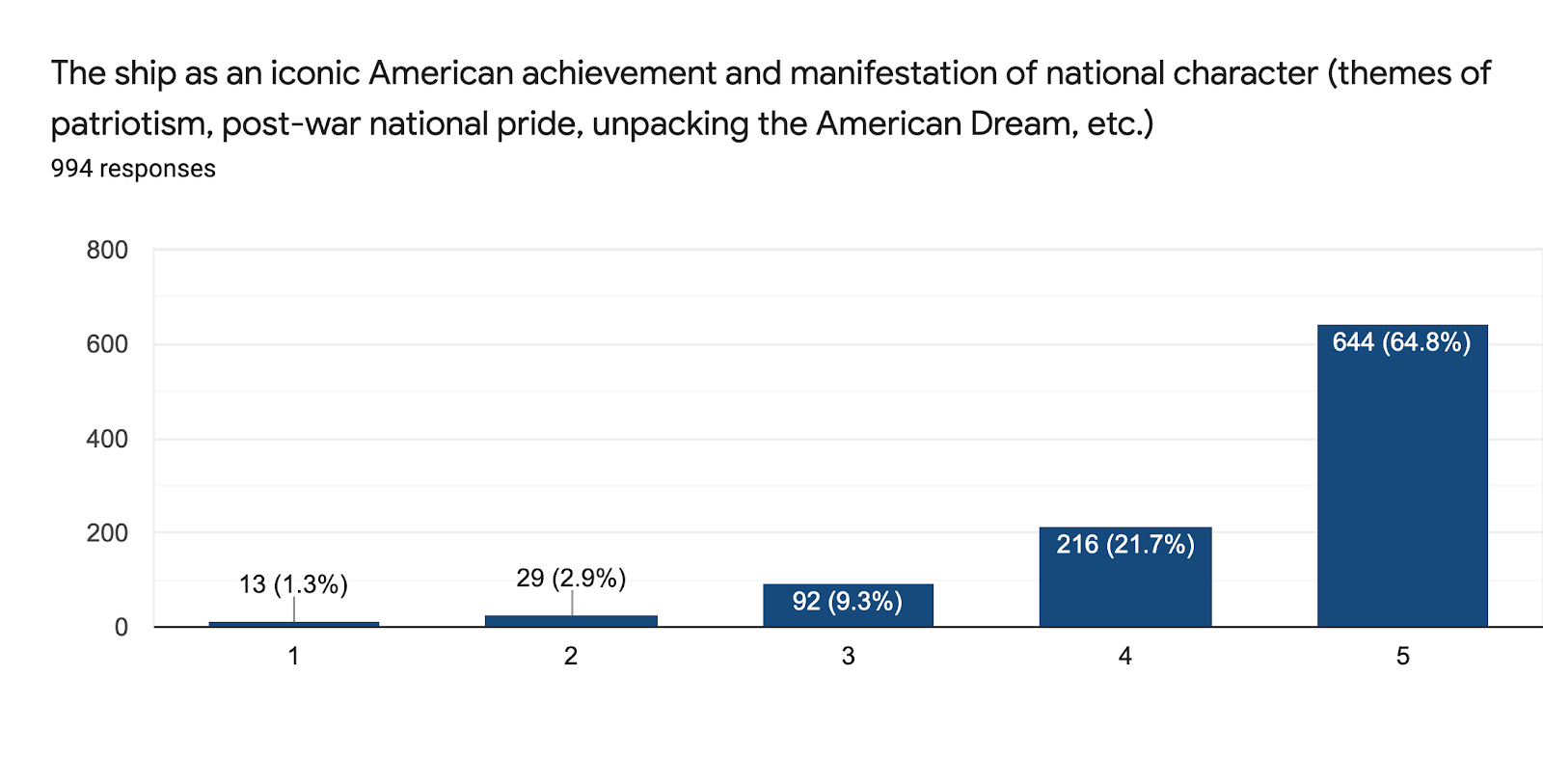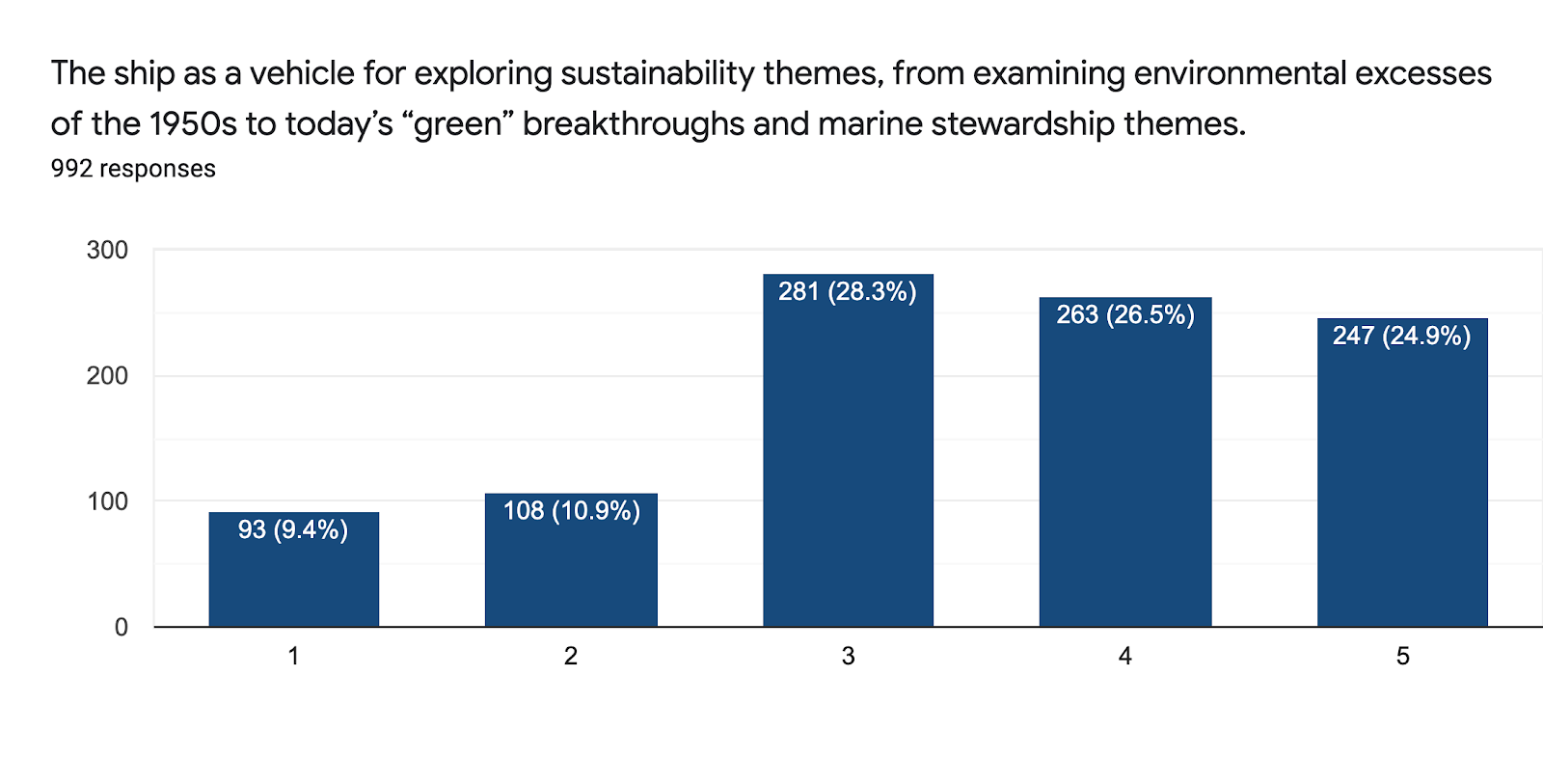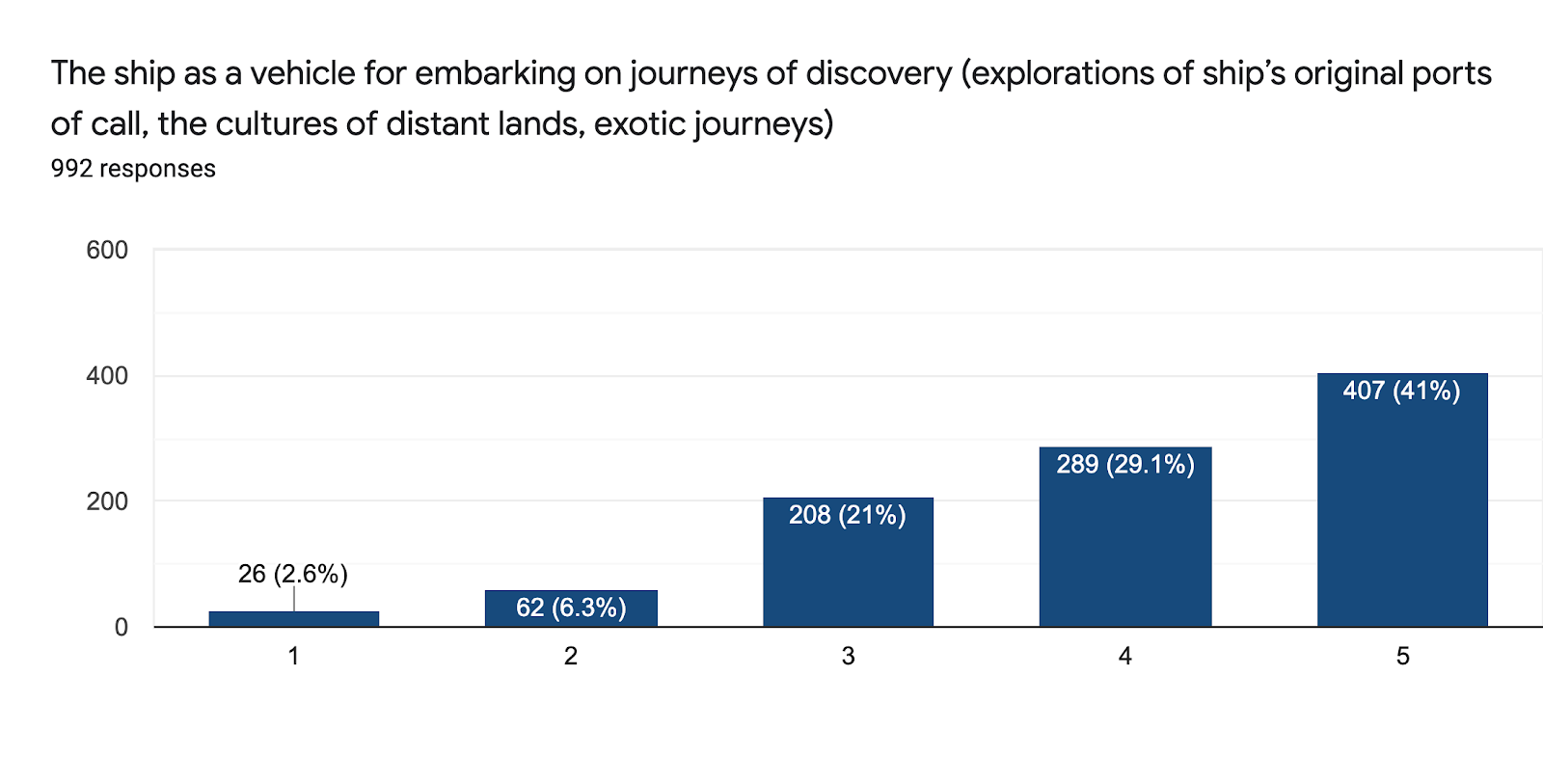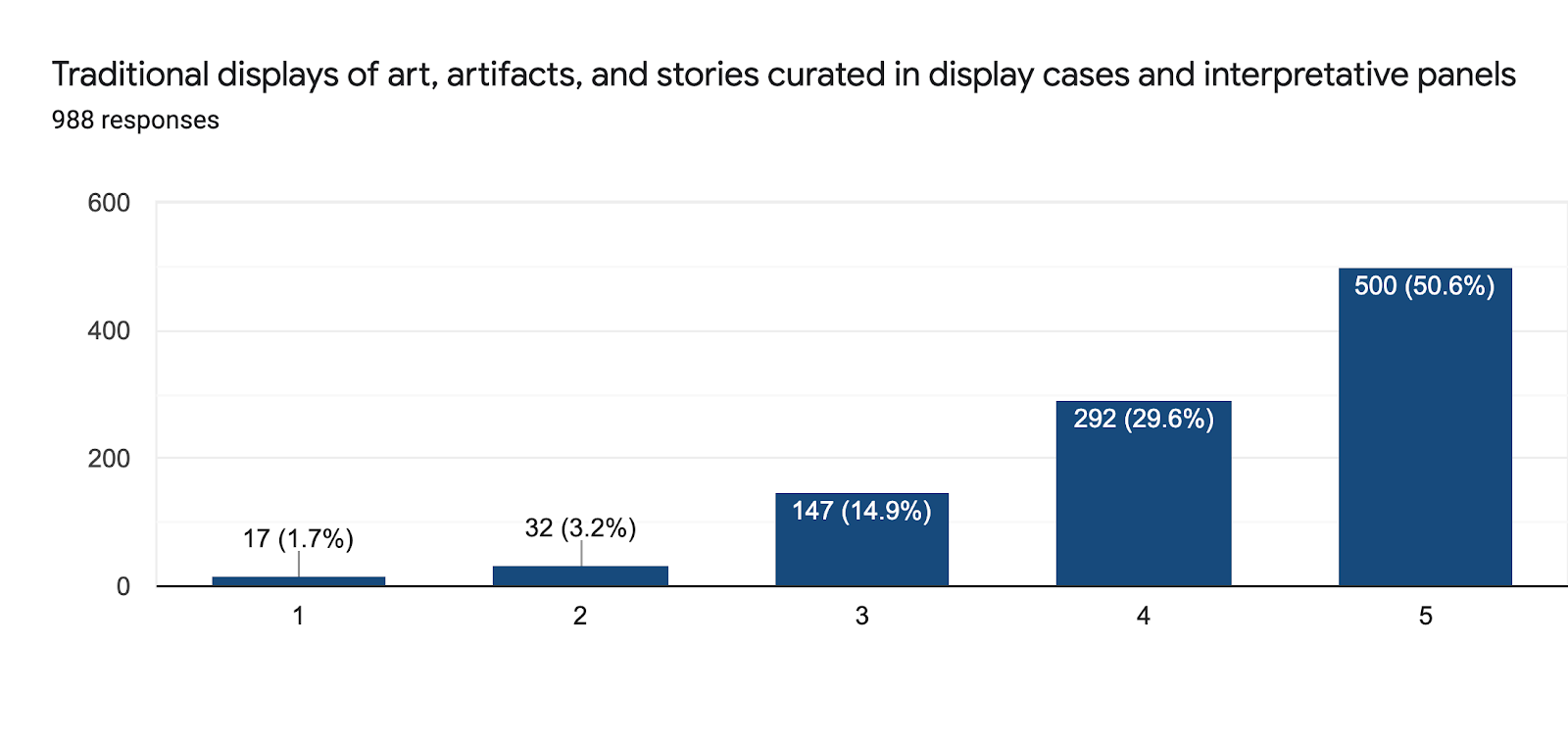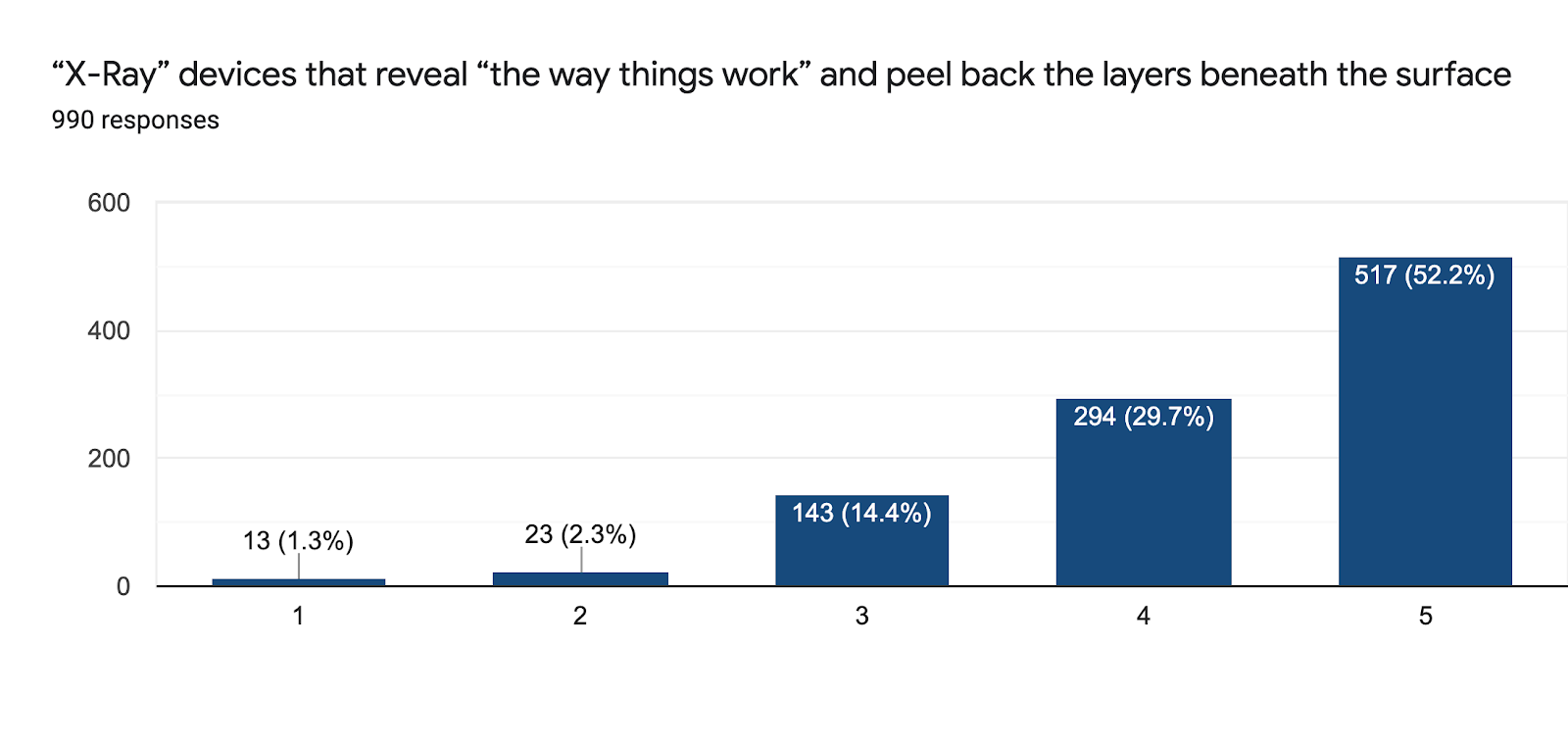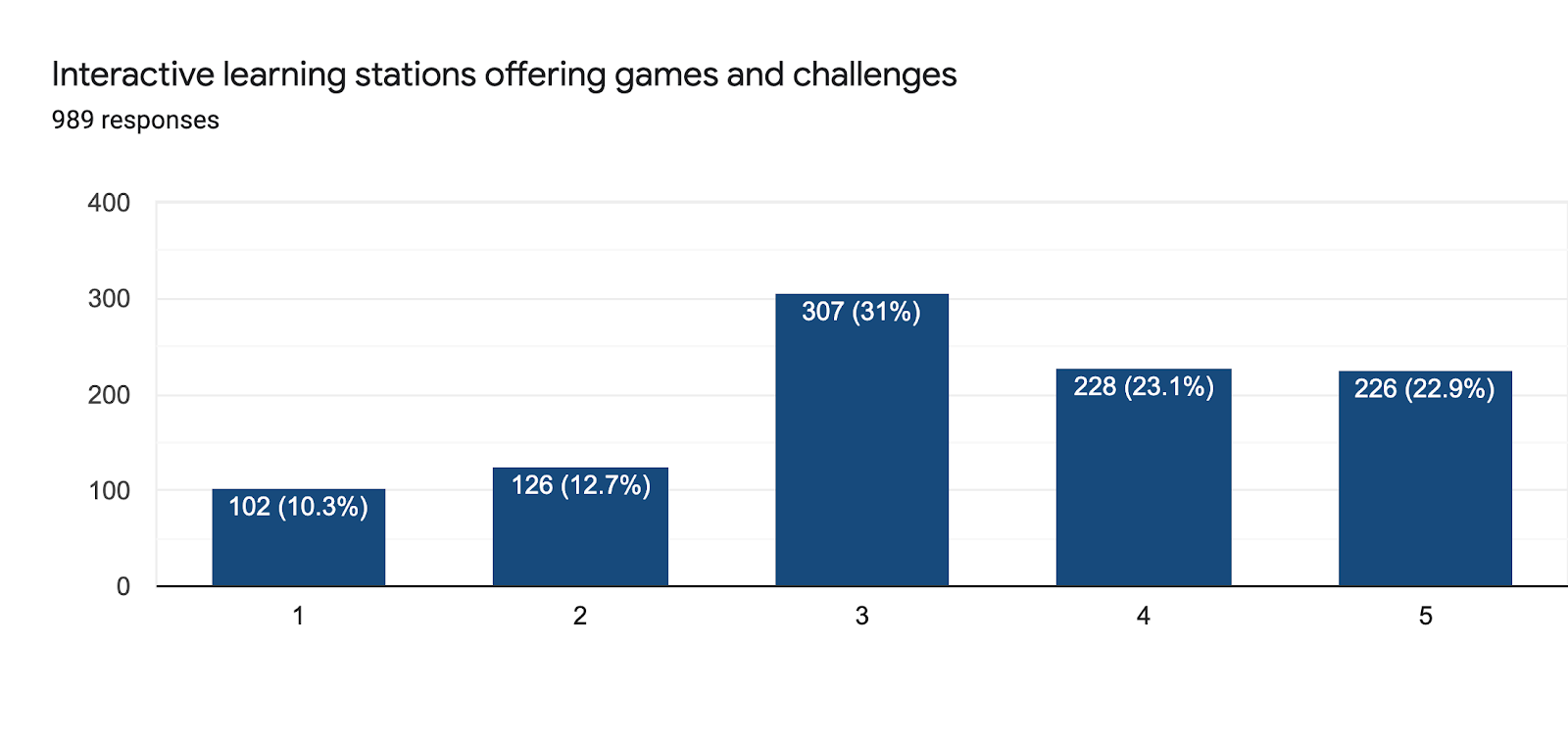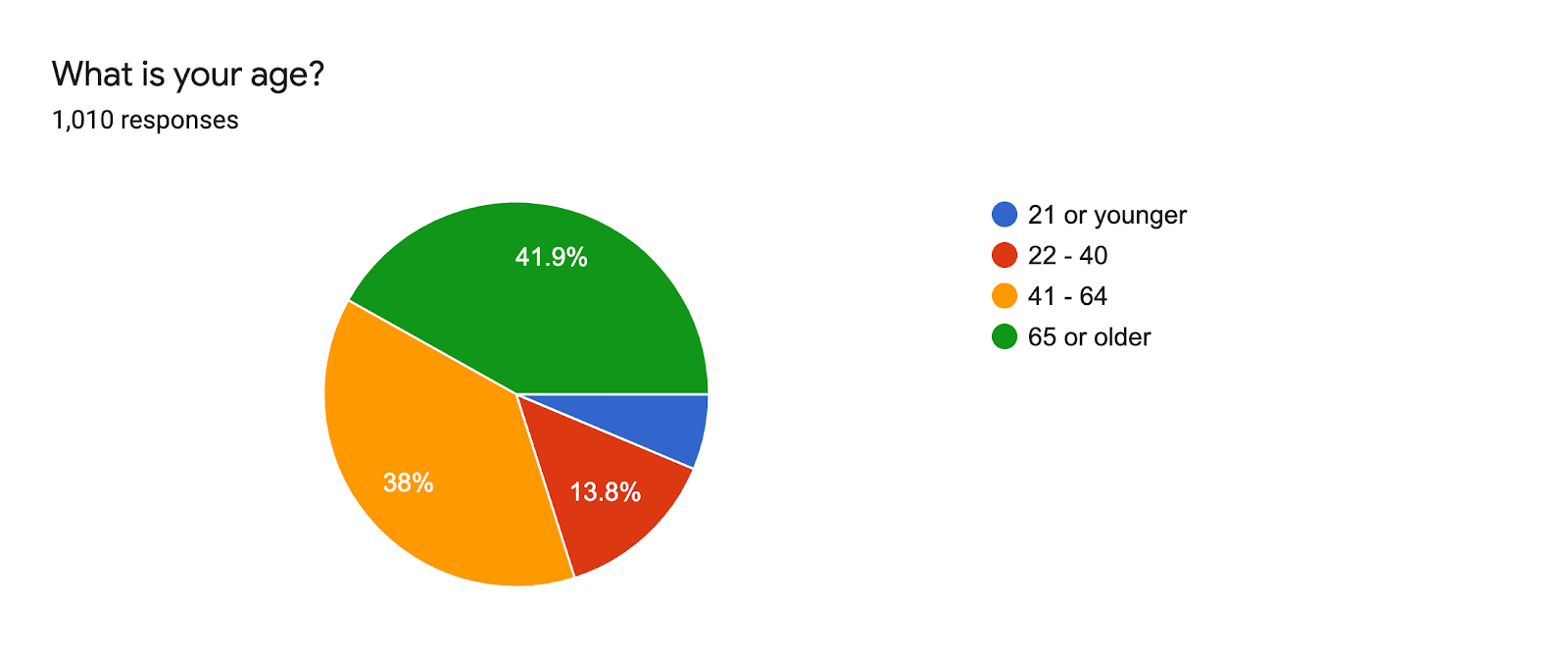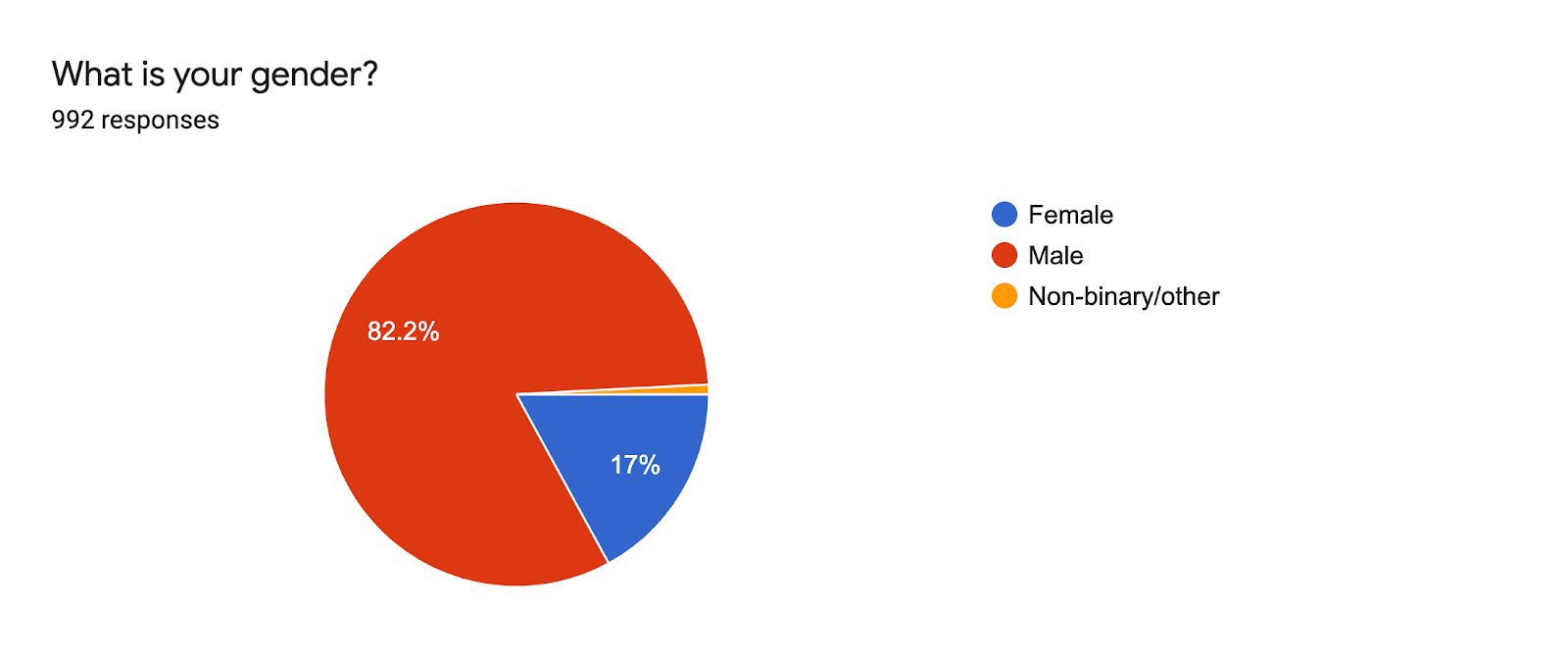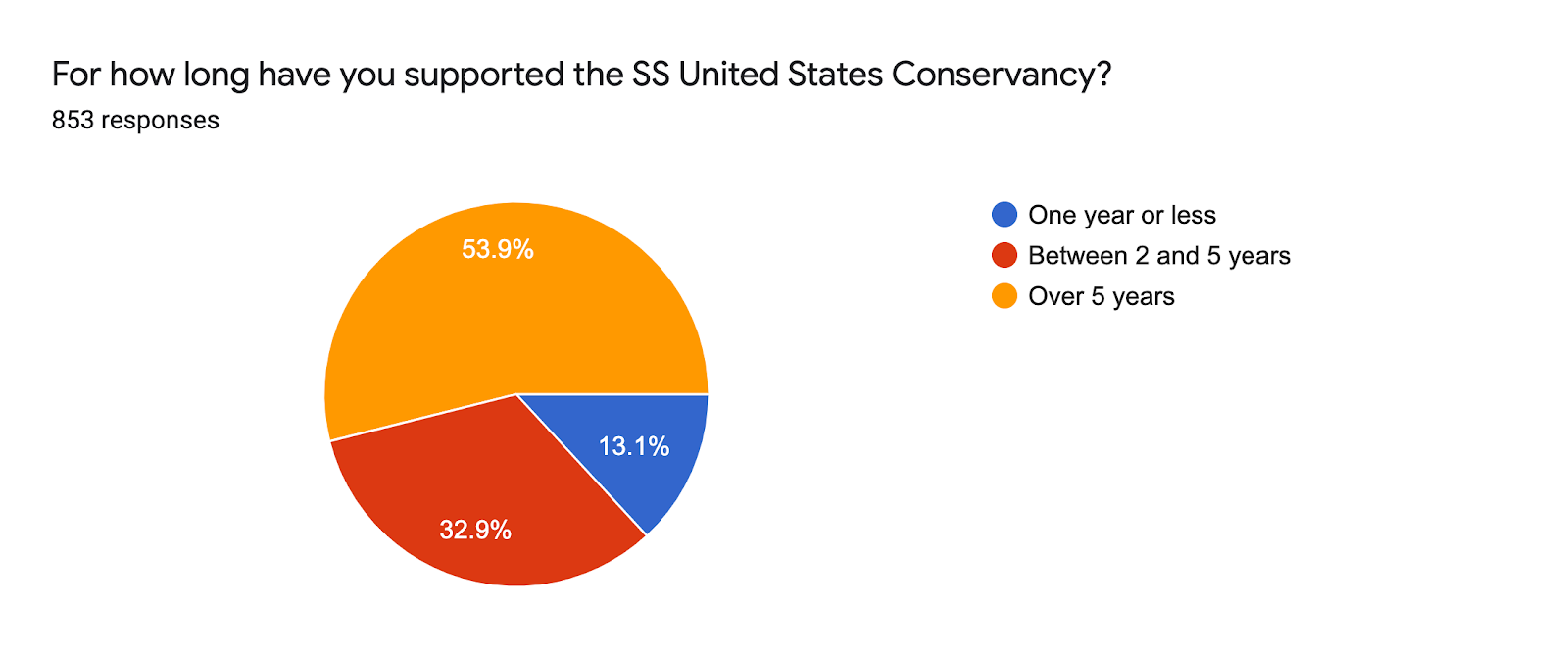Museum Planning and Charrettes
The Conservancy has initiated a comprehensive museum planning process including a series of conceptual charrettes. With support from The Roz Group and Eisterhold & Associates, these resulted in evocative renderings and potential interpretive themes for a future shipboard or land-based museum. Several daylong consultative sessions with experts explored a range of potential themes, including technological and industrial “high water marks,” pop culture and social trends of the 1950s and 1960s, the “American Century” and the nation's post-war history, and the golden age of transatlantic liners.
We also conducted a comprehensive museum and curatorial planning survey of our membership that explored a range of potential thematic and design elements in the Conservancy's future SS United States museum. The comprehensive report can be found HERE.
Museum and Visitor Experience Planning Survey
Informing the Future
The planning survey asked a variety of questions in order to better understand the broader interests of our audience base. This section outlines the survey results through readable charts and figures, and offers a brief comparative analysis of significant responses. To read the full report, click HERE.
SURVEY RESPONDENTS SNAPSHOT
42% of responders have been interested in the SS United States since her days at sea.
82.2% of responders identified as male, 17% of responders identified as female, and .08% of responders identified as non-binary/other.
41.9% of all responders were over the age of 65.
53.6 % of respondents had a personal travel story from the SS United States, whether their own experience, or that of a family member.
HIGHLIGHTS
1,027 individuals responded to the Planning Survey, representing a comprehensive cross-section of the Conservancy’s already established membership and audience.
93.8% of respondents, or 947 individuals, indicated that they would like to see the restoration or recreations of selected interior spaces aboard the SS United States.
Restored interior spaces and components of the ship, including the Passenger Interiors/Cabins, Bridge, and Captain's Quarters, were considered to be some of the highest priority spaces and components for restoration and display.
Survey respondents identified two areas of particularly high interest, with a resounding 81.2% expressing interest in seeing the Conservancy museum include a focus on the ship's groundbreaking engineering, architecture, and design. This same percentage, 81.2%, showed interest in the “golden age” of transatlantic liners and the race for the Blue Riband.
The planning survey asked a number of open-ended questions. Many of these questions offered multiple topics that respondents were asked to rank from one to five, one being “minimal interest” and five being “a great deal of interest.” In order to get the most informative results possible from the data we collected through the survey, the Conservancy employed a meticulous data analysis which included a thorough comparative analysis across responses and questions. One particularly notable set of questions asked about themes felt to be highlighted, found compelling, and exciting. While similar, these questions produced important responses that dig deep into the nuanced interests of our audience base.
For example when asked “Which themes excite you the most?,” respondents felt overwhelmingly positive about the future ship-board museum engaging with notions of the “American Dream” and the SS United States as an iconic American achievement, with 64.8% selecting “a great deal of interest.” (Figure 1.1). The percentage of responders who felt this to be an engaging theme was higher than any other topic within that section.
Figure 1.1: What aspects of the SS United States do you think should be highlighted in the Conservancy’s shipboard museum and visitor’s center? The bar graph indicates interest on a scale of 1 to 5, 1 being minimal interest and 5 being a great deal of interest.
Respondents also indicated “a great deal of interest” in the broader historical and political context of the SS United States when asked “What aspects of the SS United States do you think should be highlighted in the Conservancy’s shipboard museum and visitor’s center?” (Figure 1.2). While both of these questions garnered positive responses about the socio-political context surrounding the SS United States, when asked about “themes thought to be most compelling,” pop culture and social trends (including socio-political movements) of the 1950s and 1960s were only considered to be of moderate interest with 32.2% of respondents selecting 3 out of 5. (Figure 1.3)
Figure 1.2: The Conservancy hopes that its museum and visitor’s center will inspire and excite a wide range of visitors with varied interests. Which of the following broader themes do you think are most compelling? The bar graph indicates interest on a scale of 1 to 5, 1 being minimal interest and 5 being a great deal of interest.
Figure 1.3: The Conservancy’s future museum and visitor’s center seeks to inspire reflection and discussion of broader social, artistic, and historical themes. Which of the following themes excite you the most? The bar graph indicates interest on a scale of 1 to 5, 1 being minimal interest and 5 being a great deal of interest.
Through these responses, the Conservancy was able to pinpoint specific areas of interest for our established audience, offering the Curatorial team insights into what future visitors might like to see in a museum dedicated to the SS United States. Through a comparison of this data, the Conservancy was able to narrow down the specific topics within a more general “History” theme to come up with Potential Areas of Impact.
The Conservancy further utilized comparative analysis in order to better understand the nuanced responses within each question itself. For example, when asked “Which themes excite you most?,” the Conservancy offered multiple themes within that question that dealt with engineering, science, or technology.
Of the individuals that responded to this question, 50.7% felt “a great deal of interest” in exploring STEAM themes and, similarly, 58.6% of individuals responded with a “great deal of interest” for the ship embodying a technological and industrial “high watermark.” Alternatively, most respondents, or 28.6%, indicated only moderate interest in the ship as a vehicle for exploring sustainability themes. Again, these nuanced results help to point the Conservancy towards specific areas of interest, helping narrow down our Potential Areas of Impact to three distinct topics, Living Histories, Social (contextual) History, and Technology, Design, and Engineering.
The Conservancy also employed questions in the survey that asked responders to suggest further ideas or topics that might be relevant to future museum planning. Knowing that our audience base would have intimate knowledge of maritime and ship-board museums, the Conservancy felt that data in the form of suggestions could be useful for curatorial efforts. The survey specifically asked respondents to suggest potential museums/exhibitions to emulate, in order to be able to learn from successful similar projects. 40.6% of survey respondents indicated interest specifically in Ocean Liner Museums. Of this 40.6%, 72.9% (or 16.7% of total respondents) suggested the RMS Queen Mary as a potential museum to emulate (Figure 3.4). The next most popular liner museum to emulate is the SS Rotterdam with 20.2% (or 4.6% of total respondents) suggesting interest. From these short answer suggestions and the multiple choice data, the Conservancy has been able to pinpoint potential Engagement Practices that would best suit the curatorial collection.
The Conservancy’s future museum and visitor’s center seeks to inspire reflection and discussion of broader social, artistic, and historical themes. Which of the following themes excite you the most? The bar graphs below indicate interest on a scale of 1 to 5, 1 being minimal interest and 5 being a great deal of interest.
Figure 2.1
Figure 2.2
Figure 2.3
The following charts are selected visualizations of the data collected from the planning survey. These visualizations are representations of respondent suggestions and are meant to provide a basic overview and categorization of input shared. These charts do not reflect the entirety of the data collected, but instead reflect some of the key aspects of the data that was discussed above. An in-depth analysis of these suggestions will continue to inform the Conservancy of best practices to suit the interests of our audience.
Figure 3.1
Figure 3.2
Figure 3.3
Figure 3.4
Potential Areas of Impact:
Inspiring Future Generations
Mae, Janette, and Inez Gautier pose for a US Lines publicity still. Image courtesy of Janette Gautier.
Through survey engagement, the SS United States Conservancy has been able to outline three potential areas of impact on which the future museum might focus. These areas are: (1) Living Histories, (2) Social History, and (3) Technology, Design, and Engineering surrounding the context of the SS United States.
Living Histories
When survey respondents were asked to suggest further aspects to be highlighted within the museum space, 46.6%, an overwhelming majority, indicated their interest in some sort of historical analysis or discussion (see Figure 3.1 above). In order to understand and outline what types of history these individuals were suggesting, the Conservancy further analyzed the data labeled as History (see Figure 4.1 below) and separated it into seven separate subjects: (1) Art/Design History, (2) General History, (3) Living History, (4) Pop-Culture History, (5) Service History, (6) US History, and (7) United States Lines History. A majority of respondents, 37.4%, indicated their interest in some sort of “Living History.”
The Conservancy defines living history as including, but not limited to: (1) Crew and passenger experiences, (2) Immigration stories, and (3) Celebrity encounters. What the Conservancy defines as “Living Histories” are crucial to the preservation of the SS United States as not only an American monument but also a cultural memorial to those who played a role in the lifetime of the ship. By recording the stories and experiences of those who were directly influenced by the SS United States, including passengers, crew, as well as family members and even supporters of the ship, the Conservancy can solidify the ship as an important site for generations to come. The Conservancy intends to preserve these memories by collecting and displaying ephemera, objects, and memorabilia, as well as sharing and showcasing this content through dynamic audio, video, and digital platforms.
Social (Contextual) History
Image courtesy of Margaret Smith
When survey respondents were asked to elaborate on themes they found to be compelling, an overwhelming majority, 52.9%, also indicated an interest in History (see Figure 3.2 above). However, when analyzed further, the type of history respondents found most compelling was United States Lines History with a count of 42.2% of suggestions (see Figure 4.2 below). In the same analysis, 21.9% of respondents indicated that social history was most compelling. Interestingly, respondents also found United States Lines history most exciting, with a count of 33.3% of suggestions. The third most popular theme, with 23.3% of suggestions, was cultural context (the second most popular suggestion, with 24.4% respondent engagement was STEAM themes, which is to be discussed below) (see Figure 3.3 above).
Using this data, the Conservancy found that “Social History” is another big area of interest. The Conservancy defines “Social History” as the contextual history of the SS United States including (1) Service history and the history of United States Lines, (2) Maritime history as a crucial part of socio-political history, and (3) the History of the SS United States.
The impact of United States Lines and ocean liners on transportation was considerable. To offer faster overseas travel, in a time before the Jet Age, meant coming one step closer to a global society. It is in this sense that the service history of the SS United States can be examined in the context within which she came to be: this includes the social and political moments and movements that shaped United States history. The Conservancy will explore how to best engage with these histories through discussions of political leaders who sailed aboard the SS United States as well as collecting memorabilia from former crew and passengers. The Conservancy will also engage with artwork from the ship that touches upon socio-political issues through permanent and/or rotating exhibits and engage with immigration stories and policy.
Technology, Design, & Engineering
The Conservancy’s understanding of the theme of Technology, Design, and Engineering includes (1) Engaging with the history of the ship’s designer, William Francis Gibbs and his revolutionary design, (2) The relationship between technology and the SS United States (including the race for the Blue Riband, the incorporation of a range of technological innovations, including the Radarange, and the rise of the Jet Age), and (3) Mid-century modern design, aesthetics, and theory.
Technology, Design, and Engineering was a favorite topic among survey respondents when asked about further suggestions for themes to be highlighted, found exciting, and most compelling. 24.4% of survey respondents indicated that they found STEAM themes to be most exciting; the second most popular opinion among respondents in that question (see Figure 3.3 above). When asked which themes were most compelling, the third most popular opinion was Design/Engineering with 12.4% of respondents suggesting this theme (see Figure 3.2 above). Similarly, when asked which aspects of the SS United States should be highlighted, 14.1% of respondents suggested Design/Engineering, the second most popular opinion as well (see Figure 3.1 above). These responses indicated to the Conservancy that themes surrounding Technology, Design, and Engineering were of great interest to our audience base and offered a clearer vision of what should be a focus for future Curatorial efforts.
The SS United States was the pinnacle of post-war technology, luxury, and design and represented the best maritime innovation the world had to offer at the time. Due to the ‘Flagship’s’ iconic nature, the SS United States was also privy to some of the newest commercial technology including the Radarange, or as we know it now, the microwave, as well as air conditioning, and the “dimmer switch” for lighting. Many of these inventions were popularized through travel and use on the ship and have shaped technology today. By engaging with the themes of Technology, Design, and Engineering the Conservancy is able to consider the impacts the SS United States had on the world in her own time, but also highlight the technological advancements that were developing around her. By thinking critically about the technology and design of and aboard the SS United States, the Conservancy has the opportunity to make crucial connections to today’s trends and progressions. The Conservancy can engage this theme by displaying blueprints and specs of the SS United States and detailing the design of the ship for the audience, using innovative techniques as an homage to the groundbreaking engineering of the ship. By providing a thorough framework of the ship’s engineering and design processes, visitors will be able to better understand what made the SS United States a truly remarkable entity.
Conceptual rendering of the SS United States by author-illustrator David Macaulay.
The following charts are selected visualizations of the survey data collected in the survey's open-ended questions. These visualizations do not reflect the nuance and specifics of this data, but instead depict it in broad categories. The Conservancy has retained the full responses to the survey's open-ended questions, and this detailed input will continue to guide and inform the Conservancy's museum planning process going forward.
Figure 4.1
Figure 4.3
Curatorial Practices and Collections Engagement:
Preserving a Legacy
Photograph from the SS United States Conservancy's Albert W. Durant Photography Collection
Through survey analysis, the Conservancy outlined three specific categories of engagement that would best serve the collection and audience participation: (1) Restoration, (2) Display, and (3) Interactivity. Through a combination of these three curatorial practices, the Conservancy hopes to capture the interests and imaginations of audience members of all ages and demographics.
Restoration
The topic of restoration was a popular theme among survey respondents, with 93.8% indicating an interest in seeing replicas of staterooms or other interior spaces, and 19.8% (or the second most popular) of respondents indicating that restoration was a crucial aspect to be highlighted (see Figure 3.1 above). When asked to suggest further themes or topics for the Conservancy to engage with, the majority of respondents, or 33.6%, indicated further interest in restoration of spaces onboard (see Figure 5.1 below). Additionally, when asked to suggest further interpretive or engaging exhibition practices, 13.2% of respondents indicated that restoration was of great interest, making it the third most popular recommendation. Specific spaces or elements of interest for restoration were the Propellers, Engine Room, Cabin/Staterooms, and the Navajo Lounge.
The Conservancy’s most important role is the continued preservation of the SS United States and her history. As noted previously, the interiors of the vessel were entirely removed by a previous owner for asbestos abatement and preparation for redevelopment, so iconic spaces would necessitate recreation rather than restoration. Through redevelopment, it is possible to bring certain aspects of the ship back to life and offer a glimpse at what it was to travel aboard the SS United States. From analyzing this survey, the Conservancy was able to further identify our audience’s desire for the restoration and/or recreation of select, iconic, shipboard spaces. This information will help to create a foundation upon which the Conservancy can pursue restoration projects that best preserve the ship’s history while also maximizing audience engagement.
Display
Image courtesy of the Craig Family Archive
Displays and exhibitions will be the backbone of public engagement with the history and importance of the SS United States. The SS United States Conservancy’s shipboard museum will potentially employ a variety of techniques aimed at engaging and inspiring audiences of all ages and interests.
To better understand the types of displays our audience base might respond to, the planning survey asked “Which program components and interpretive devices do you enjoy when you visit museums?” The most popular topic selected, with 52.2% of respondents indicating a 5 out of 5, was “x-ray devices” that reveal “the way things work” and peel back the layers beneath the surface (see Figure d.2 below). This response received the majority of interest by survey respondents indicating a high level of interest in informational displays about the design and engineering of the ship. The second most popular type of display was traditional displays of art and artifacts in display cases with 50.6% of survey respondents indicating a “great deal of interest” (see Figure d.1 below).
To better understand what specifically it was that the audience felt should be showcased, the Survey asked which specific object or exhibition should be included in the future museum? Individuals generally responded in one of four categories:
(1) Art/Artifacts (30.8%)
(2) Object Restoration ( 30.3%)
(3) Service Objects ( 23.6%)
(4) Engineering (15.3%) (Figure 5.3)
Of the most popular category, Art/Artifacts, the most common suggestions were (1) Artwork found on board and (2) the Original Steinway Piano, both of which had 20.7% of suggestions (see Figure 5.4 below). The two most popular Restoration suggestions were (1) the restoration or recreation of the Engine Room and (2) a General restoration/redevelopment of the ship itself (see Figure 5.5 below).
By asking questions specifically thinking about display, the planning survey helped the Conservancy to pinpoint particular objects and types of exhibitions desired by our audience base. In turn, this information will aid in setting a foundation for future curatorial efforts including potential objects to be permanently displayed within the museum space as well as engaging themes for temporary exhibitions.
Interactivity
As discussed previously, various spaces on board the SS United States are not feasible to restore and will be activated commercially, rather than utilized for the museum. This, however, serves as an opportunity, rather than a setback, for the future museum and visitor’s center in which to engage our audience in unconventional and innovative ways. Using today’s cutting edge technologies, the Conservancy has the unique opportunity to create interactive and educational spaces within a museum setting. The incorporation of technology, such as games, virtual reality, or interactive devices, into future exhibitions will not only allow the Conservancy to recreate and showcase important spaces on board the SS United States, but will also appeal to a wide range of audiences and their individual interests.
Jim Davis during his 1959 voyage from New York City to the United Kingdom. Jim's father convinced the captain to take them to the bridge.
Image courtesy of Jim Davis
In response to the question: Which program components and interpretive devices do you enjoy when you visit museums?, survey respondents indicated “a great deal of interest” in x-ray devices that reveal the way things work with 52.2% of respondents selecting 5 on a scale of 1 to 5 (see Figure d.2 below). The third most popular selection was 3D encounters with key figures using virtual reality with 46.8% of respondents indicating “a great deal of interest”(see Figure d.3 below). Interestingly, the selection considered least popular was Interactive learning stations offering games and challenges with the majority of respondents, or 32%, voting “moderate interest”or a 3 out of 5 (see Figure d.7 below).
The planning survey also asked respondents to suggest further methods of engagement so that the Conservancy might obtain the opinions and interests of the audience base in their own words. Of the suggestions given, the three most popular categories, or themes of engagement were: (1) Lectures and films, (2) Education- based Initiatives, and (3) Restored/Recreated Spaces.
The following charts are selected visualizations of the survey data collected in the survey's open-ended questions. These visualizations do not reflect the nuance and specifics of this data, but instead depict it in broad categories. The Conservancy has retained the full responses to the survey's open-ended questions, and this detailed input will continue to guide and inform the Conservancy's museum planning process going forward.
Figure 5.1
Figure 5.2
Figure 5.3
Figure 5.4
Figure 5.5
Figure 5.6
Conclusion: Gathering Inspiration Into Action
Ocean liners, and maritime travel in general, transformed and redefined the United States from its earliest years as a nation. At a time when the only way to cross the Atlantic Ocean was by ship, the speed and ease with which ocean liners did so made the world much more accessible and helped to create today’s global community. The SS United States in particular changed maritime transportation in ways that still impact and influence engineers, passengers, and consumers alike. It is central to the Conservancy’s mission to ensure that the SS United States is preserved but also used as a catalyst for education and meaningful discussion. The “Big U” not only shines a light on the enduring themes of American innovation and ingenuity, but it also can act as a lens through which we can view topics like immigration, pop culture, social and art history, and technology, in new and exciting ways, while celebrating the history of the United States.
While the data gathered by the planning survey is important to the growth and cultivation of a successful future museum and visitor’s center, the Conservancy also acknowledges that there is more information to be gathered and work to be done. The results of the survey are a preliminary, yet critical, step in the larger process of developing a space that both appeals to our audience base, yet also a powerful draw to a broader audience that might not have normally engaged with the SS United States.
One of the biggest challenges for any museum, let alone a museum dedicated to the history and preservation of a single space, is to create content that continually captures the attention and inspires visitors across generations. By learning more about what our current audience base hopes to see in the museum, as well as what they find inspiring and engaging, the Conservancy is able to put these responses, and the information, gathered into action.
Image courtesy of Nick Landiak
Additional Results
The following data visualizations reflect nearly the entire collected data from the Museum Planning Survey. This includes: demographics of the respondents, short answer data visualizations, and results previously discussed in the report. The bar graphs indicate interest on a scale of 1 to 5, 1 being minimal interest and 5 being a great deal of interest.
